Leucism

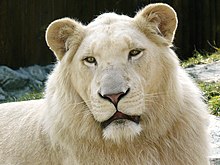


Leucism (/ˈluːsɪzəm, -kɪz-/) is a wide variety of conditions which result in the partial loss of pigmentation in an animal—which causes white, pale, or patchy coloration of the skin, hair, feathers, scales or cuticles, but not the eyes. It is occasionally spelled leukism. Some genetic conditions that result in a "leucistic" appearance include piebaldism, Waardenburg syndrome, vitiligo, Chédiak–Higashi syndrome, and Melanophilin mutations. Pale patches of skin, feathers, or fur (often referred to as "depigmentation") can also result from injury.
Details
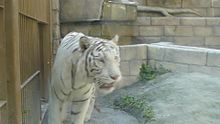 Play media
Play media'Leucism' is often used to describe the phenotype that results from defects in pigment cell differentiation and/or migration from the neural crest to skin, hair, or feathers during development. This results in either the entire surface (if all pigment cells fail to develop) or patches of body surface (if only a subset are defective) having a lack of cells that can make pigment.
Since all pigment cell-types differentiate from the same multipotent precursor cell-type, leucism can cause the reduction in all types of pigment. This is in contrast to albinism, for which leucism is often mistaken. Albinism results in the reduction of melanin production only, though the melanocyte (or melanophore) is still present. Thus in species that have other pigment cell-types, for example xanthophores, albinos are not entirely white, but instead display a pale yellow colour.
More common than a complete absence of pigment cells is localized or incomplete hypopigmentation, resulting in irregular patches of white on an animal that otherwise has normal colouring and patterning. This partial leucism is known as a "pied" or "piebald" effect; and the ratio of white to normal-coloured skin can vary considerably not only between generations, but between different offspring from the same parents, and even between members of the same litter. This is notable in horses, cows, cats, dogs, the urban crow and the ball python but is also found in many other species.
Due to the lack of melanin production in both the retinal pigmented epithelium (RPE) and iris, those affected by albinism sometimes have pink pupil due to the underlying blood vessels showing through. However, this is not always the case and many albino animals do not have pink pupils. The common belief that all albinos have pink pupils results in many albinos being incorrectly labeled as 'leucistic'. The neural crest disorders that cause leucism do not result in pink pupils and therefore most leucistic animals have normally coloured eyes. This is because the melanocytes of the RPE do not derive from the neural crest. Instead, an out-pouching of the neural tube generates the optic cup that, in turn, forms the retina. As these cells are from an independent developmental origin, they are typically unaffected by the genetic cause of leucism.
Genes that, when mutated, can cause leucism include c-kit, mitf and EDNRB.
Etymology
The terms leucistic and leucism are derived from medical terminology (leuc- + -ism). The stem leuc- is the Latin variant of leuk- from the Greek leukos meaning "white" (see Stedman’s, Dorland’s or Taber’s medical dictionaries).
Examples in nature
Leucism has been noted in a number of animal species, including:
- European hedgehog
- Kermode bear
- White buffalo
- Kenyan white giraffe
- Seneca white deer
- Leucistic giraffes in Kenya (14 December 2017)
- White stag
- American Alligator
- Moose
- Killer whale
- King cobra
- Mute swan, 'Polish swan', Cygnus olor morpha immutabilis
- Black Billed Magpie
- American crow
 An American crow with leucism. The wings are whiter than the rest of the body, and the eyes and bill are black.
An American crow with leucism. The wings are whiter than the rest of the body, and the eyes and bill are black.
Examples in fiction and mythology
- Moby Dick
- White stag
- Kimba the White Lion
- Father of the Pride
- Kung Fu Panda 2
Gallery

Leucistic Texas rat snake (Elaphe obsoleta)
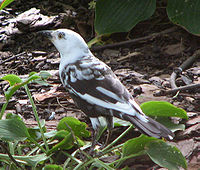
Leucistic common grackle (Quiscalus quiscula)

Leucistic Indian peacock (Pavo cristatus)
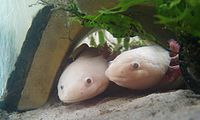
Leucistic axolotls (Ambystoma mexicanum)
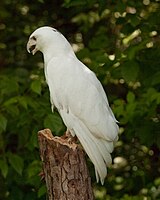
Leucistic red-tailed hawk (Buteo jamaicensis)

Leucistic western jackdaw (Corvus monedula) in Naantali, Finland
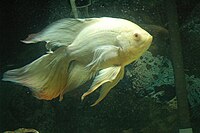
Leucistic long-finned oscar (Astronotus ocellatus)
Leucistic American rhea (Rhea americana)

Leucistic reed bunting (Emberiza schoeniclus)
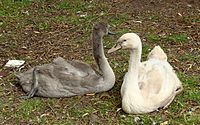
Leucistic mute swan cygnet (Cygnus olor) compared to a non-leucistic cygnet
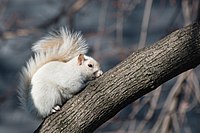
Leucistic squirrel
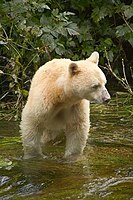
A Kermode (or spirit) bear is a leucistic American black bear. It is found only in the forests of British Columbia. It has a mutation in the gene for MC1R.
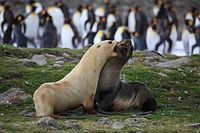
Leucistic Antarctic fur seal with MC1R mutation.
See also
- Albino and white squirrels
- Amelanism
- Dyschromia
- Erythrism
- Heterochromia iridum
- Melanism
- Piebaldism
- Vitiligo
- Xanthochromism













